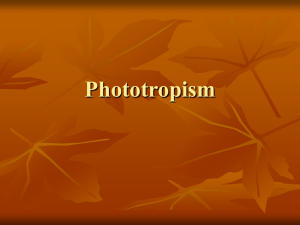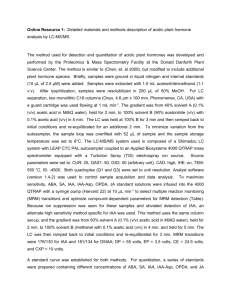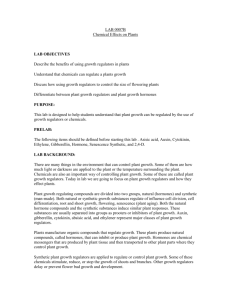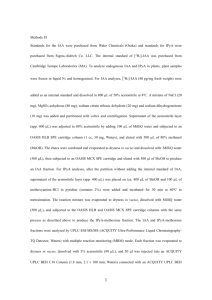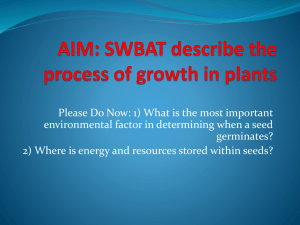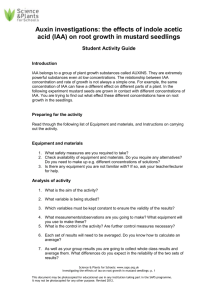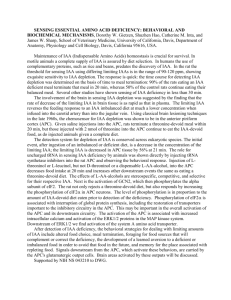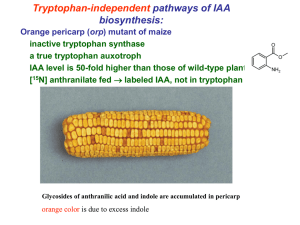Plant Responses: Tropisms, Growth Regulators & IAA Experiment
advertisement
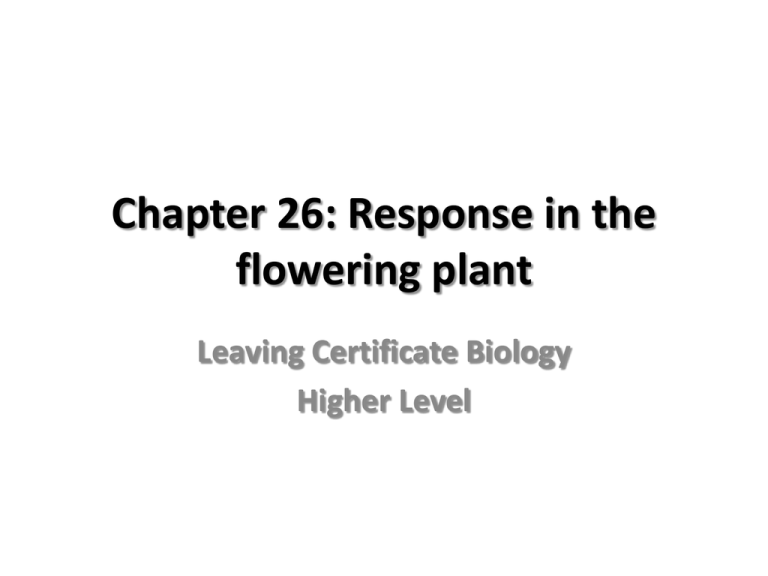
Chapter 26: Response in the flowering plant Leaving Certificate Biology Higher Level Growth Regulation • Growth of plants is controlled by growth regulators • Growth regulator levels in the plant are controlled by tropisms • A tropism is the response of a plant to a change in its external environment or to a specific stimulus Phototropism • Phototropism is the growth of a plant in response to light • Example is when plants bend towards a window Geotropism • Geotropism is the growth of a plant in response to gravity • Example: as soon as young root emerges from seed it grows towards gravity regardless of what orientation the seed was in Hydrotropism • Hydrotropism is the growth of a plant in response to water • Example: roots grow towards water Chemotropism • Chemotropism is the growth of a plant in response to chemicals • Example: roots grow towards minerals and away from heavy metals Thigmotropism • Thigmotropism is the growth of a plant in response to touch • Example: ivy growing up a wall or around a tree Growth Regulators • A growth regulator is any chemical that controls the growth of a plant – Growth regulators are produced in extremely small amounts usually in the meristematic areas of a plant – Growth regulators are thought to be transported by vascular tissues to other areas of the plant but can also diffuse through ground tissue Growth Regulators • The effects of growth regulators depend on various factors: – The area where it is located – The concentration (high concentrations can have opposite effects to very low concentrations) – Growth regulators can cause growth or inhibit growth depending on interactions with other growth regulators Examples of Growth Regulators – Growth promoters: • Auxins (indole acetic acid [IAA] – cause stem and root growth – Growth inhibitors: • Ethene (ethylene) – causes fruit to ripen • Abscisic acid – helps plants deal with harmful conditions: – causes stomata to close in very dry conditions despite presence of light) – Inhibits germination until ideal conditions are present Phototropism Anatomical & Chemical Protection • Anatomical: – Bark/dermal tissue/cuticle: functions in protecting plant – Stomata and guard cells: control water loss • Chemical: – Heat shock proteins: produced during times of stress to protect the enzymes within plant cells – Phytoalexins: produced when plant is infected with microorganisms and help kill microorganisms, prevent further spread of the invader, and warn nearby plant cells Mandatory Experiment: to Investigate Effect of IAA on Plant Tissue Leaving Certificate Biology Higher Level Apparatus: • • • • • • • • Graduated cylinder Weighing scales Beakers Stirrers Spatula Petri dishes Pipettes Deionised water • • • • • • • Cotton wool Filter paper Masking tape Ruler IAA( Indole Acetic Acid) Ethanol Cress seeds/Mustard seeds/Radish seeds Method: • Dissolve 100 mg IAA in 2 ml ethanol • Transfer to 1 L graduated cylinder and top up to 1 L with deionised water to give 100 mg/L IAA stock solution • Transfer 10 ml IAA stock to first petri dish labelled A • Transfer 1 ml of this solution in A to B and top up with 9 ml deionised water • Mix B and transfer 1 ml of B to C • Repeat procedure until dish G • Dish H is control with 9 ml deionised water Method (continued) • Place 5 cress seeds in line in the lid of each petri dish • Cover seeds carefully with filter paper • Transfer the serially-diluted solutions to each lid • Place layer of cotton wool into each lid and place base on • Seal each dish with masking tape and stand on sides in incubator set at 25 ˚C Results • After 2 – 3 days remove petri dishes and seedlings • Using ruler measure length of root and shoot for each concentration of IAA and record in table • Calculate % increase or % decrease for each concentration Conclusion • IAA stimulates growth of roots and shoots up to a certain concentration • High concentrations inhibit growth
